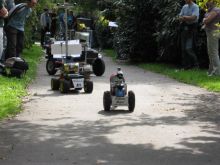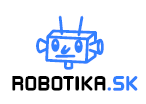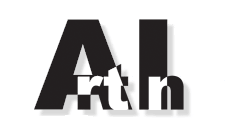Rules
mandatory payload
Sixth year of this autonomous outdoor robot contest will be held on 17th September 2011. It will take place in Austria in one of the preselected parks in Vienna. Similarly to last year robots will get only map and coordinates of destination. The start will be again concurrent for all robots. For the first time the payload (five liter barrel) will be mandatory.
Goal
The objective of the Robotour contest is to encourage development of robots
capable of transporting you to work in the morning or to deliver the building
material you have just purchased in an online shop. The path to this goal is
neither easy nor short, but
we believe that the outcome is worth it .
Maps
In the previous years there was an abundant mapping of the environment shortly
before the contest itself. These maps spread from simple records of the traveled
distance (odometry) and direction (compass) to a non-trivial image analysis
saving notable points along the way.
This technique of navigation restricts the robots only to places where
their creator spent often several days of relatively tiring and exhausting
work to build a very specific map that can be used only by her robot.
It is relatively clear, that to create a map
for a robot to travel
from Písek to Opava won't be a one afternoon job with this technique.
But there is a map available to the general public:
Open Street Map. Many people cooperate on
its creation and this way
the coverage is getting better every day. This is possible only because
everybody agreed on how the map should look like. The key concept
embraced by open street map is
verifiability. To quote
the page – information in the map is verifiable if it can be demonstrated
to be true or false. Also it is verifiable if and only if independent users
when observing the same feature would make the same observation every time.
It is not our goal to start discussions about shared robotic maps. We want
to build on what has been already achieved by Open Street Map.
Motivation for year 2011
The sixth year of this contest should be a next step towards smarter and more
autonomous robots. In contrast to the previous years robots get only a map and
coordinates of the destination. The robots should be able to navigate around
the park even if they have never been there before. The map and the destination
should be the only information the robots get before the start. Robot
successfully solving this task should be able to demonstrate its ability with
a corresponding map in any park.
The robots have to carry a payload (this used to be option, now it is
mandatory). Moreover it must be easy to load/unload. The start will be
concurrent from one place to increase spectators attractiveness.
Rules
Task The task for the robots is to deliver payload in given 30 minutes time
limit to destination as far as 1km. Robots must be fully autonomous, not leave
the road and choose correct path on junctions. The place of
start and destination will be the same for all robots.
Map The robots can only use++ Open Street Map.
The key concept of this map is its
verifiability. Anything
that is verifiable and is described in
map features can be used
by the teams to update the map of the contest area.
Note, that Open Street Map is primarily used for people, and certain rules have
to be respected.
Robots Team can deploy only one robot this year. Every robot must have
EMERGENCY STOP button, which stops its motion. The button must be easily
accessible, red and must be fixed part of the robot (Big Red Switch), so it
could be used in case of danger. The minimum size of the switch is defined
by an inscribed circle with diameter of 2cm. The team must show that it is easy to
manipulate with the robot — two people must be able to carry it several tens
of meters. There is also minimal size — robot has to carry full 5l beer barrel.
Leaving the road The robots are expected to stay “on the road” which
means to stay on the paved passage ways. If any robot leaves the road, the
trial ends. The team has to take care of their robot and remove it
immediately.
Obstacles There could be obstacles on the road. Besides natural obstacles
like benches there could be also artificial obstacles. A typical (artificial)
obstacle is for example a figurant, a banana paper box or other robot. Robots
may not touch an obstacle. Contact with an obstacle means end of the trial. The
robot may stop in front of the obstacle and visually or acoustically give
notice. Note, that the robot has to detect, that the obstacle is no longer
present.
Robots Interaction The cases where a faster robot catches up a slower one
won't be explicitly handled. The faster robot can handle the slower robot as an
obstacle, i.e. avoid it or wait until the „obstacle” disappears. In general
the road
rules will be respected: right of way, avoidance to the right, passing on the
left.
Start All robots will start simultaneously from the same park road. Start
area for each team will have approx. 1.5x1.5 meters. Start areas will follow
one after
another on one side of the road. In the start area each team can place its robot
as they see fit. The order of robots on start is given by the results the in
previous round(s) (a better robot will be closer to the destination). The order in the
first round will be given by the order of successful homologation. Robots start
automatically via their internal timers. One minute before the start, no interaction with the robot is allowed.
Robot, which starts before official start time,
will be disqualified for given round and will get zero points.
Blocking traffic Due to the crowds of robots in potential narrow roads it
is necessary to deal with traffic blockage. Every team can in any time sue a
robot of another team that is blocking road. From that moment sued robot has
one minute to leave an area defined by +/- one meter from its current
position. If the robot fails to leave this area it will be stopped and removed
from the road. Otherwise the contest continues and suing team gets warning for
false judge. If this is for the 3rd time the robot of suing team is stopped and
removed from the road.
Score The team whose robot manage best to proceed along the route wins.
The aerial distance of the last robot position (leaving the road,
a collision or a timeout) to destination is critical. For every meter towards the
destination team
gets one point. In every round a robot can get at most the aerial
distance of the start and the destination.
Organization The contest will consist of 4 trials for each team. The start
and destination will be different for every trial. The selected destination
will be announced to all teams 10 minutes before the start. The speed of the
robots is not important (actually it is limited to 2.5m/s). All points gained
during all trials will be summed together. The trial starts at a specified
time and ends after 30 minutes. The robot must leave the start area within
10 minutes of the start.
Each team has to arrange for one person familiar with the rules that
will be part of the referee team during the competition.
Homologation A team can participate in the contest if it is able to score
at least one point. Necessary condition is the ability to travel 10 meters
long route fragment without collision with an obstacle. The start procedure
will be tested (automatic start) as well as the functionality of the EMERGENCY STOP.
Usage of liquids, corrosive, pyrotechnic material and live beings is strictly
prohibited. Every robot has to be accompanied by a team member, older 18 years,
who is fully responsible for the robot behavior.
Technical documentation Every team has to provide basic technical
documentation about their robot (for presentations, general public and
journalists). Three winning teams will be asked for more detail description for
website presentation and easier entry of novices in the next year.
Basic differences between last and this year contests
- The payload (a full five liter barrel) is mandatory.
- New rule about blocking the traffic.
- The robots should be prepared for bad weather conditions.
Where and when?
For the general public the contest will be held on Saturday September 17th 2011 in Vienna/Austria,
10-17h in one of three preselected parks. In the case of very bad weather the
contest can be postponed to Sunday.
For the teams this will be three-day-event: there will be homologations on
Friday, contest on Saturday and a small workshop on Sunday (theme “what is
actually hidden in your unique machines”).
Registration
If you would like to participate in the contest, please let us know using
contact form. The final dead-line
for registration is 31st of July 2011 (extended to 15th of August 2011).
If you would like to support this contest or you have something interesting to
offer, let us know.
Organized by:
Sponsors:
Send email to the editors
Your message could not be sent
but you can also reach us at webmaster-at-robotika.cz
Your message was successfully sent.
You need to turn on javascript to submit this form.





